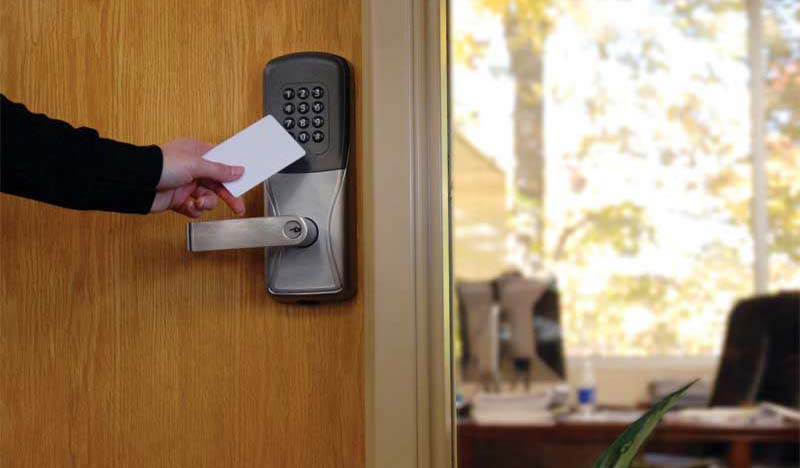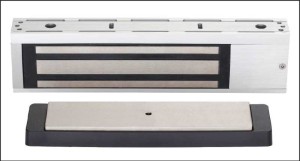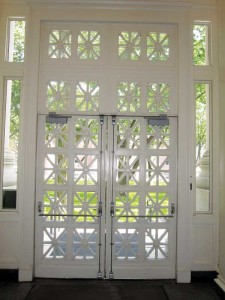Code requirements for doors with access control
by Catherine Howlett | March 1, 2013 4:46 pm
 [1]
[1]by Lori Greene, AHC/CDC, CCPR, FDAI
When specifying electrified hardware for an access control system, there is often confusion about which code requirements to follow and which system components are needed. For example, one set of requirements is titled “Access-controlled Egress Doors,” leading to a common misunderstanding all electrified hardware used with an access control system must comply with this section.
“Access-controlled Egress Doors” is found in both International Building Code (IBC) and National Fire Protection Association (NFPA) 101, Life Safety Code, as Section 1008.1.4.4 and 7.2.1.6.2, respectively. It is typically applied to doors with electromagnetic locks released by a motion sensor. These types of locks are essentially an electromagnet in a housing mounted on the underside of the frame head, and a steel armature mounted on the door face.
When the magnet is energized, it bonds to the armature and locks the door. To allow access or egress, a switch must be provided to de-energize the magnet. In addition to the motion sensor, the lock must be unlocked by actuation of the fire alarm system, loss of power, and a signal from a push button mounted within 1.5 m (5 ft) of the door, which unlocks the lock for 30 seconds independent of the access control system.
 [2]
[2]The 2009 IBC includes a new section—“Electromagnetically Locked Egress Doors” (1008.1.9.8)—that allows doors with electromagnetic locks to be addressed in another way. The 2009 NFPA 101 added a similar section, called “Electrically Controlled Egress Door Assemblies” (7.2.1.5.5). When electromagnetic locks are specified, either the original “Access-controlled Egress Doors” section or the new sets of requirements may be used, depending on the application and the edition of the code applied to the project.
The difference with the new requirements is the electromagnetic lock may be released by a door-mounted device instead of a motion sensor and push button. This door-mounted release device could be panic hardware or a lockset with a request-to-exit (RX or REX) switch, or a bar with an electronic touch sensor. This code section does not require the lock to unlock upon actuation of the fire alarm, but only when there is power loss to the switch in the door-mounted hardware.
Comparing the requirements
The two sets of requirements, as shown in the 2009 IBC (NFPA 101 requirements are very similar), bear comparison.
1008.1.4.4–Access-controlled Egress Doors
- applies to entrance doors in a means of egress and entrance doors to tenant spaces;
- allowed in Use Groups:
– A (Assembly);
– B (Business);
– E (Educational);
– I-2 (Institutional–Hospitals and Nursing Homes);
– M (Mercantile);
– R-1 (Residential–Hotels, Motels, and Boarding Houses); and
– R-2 (Residential–Apartments and Dormitories);
- a sensor must be mounted on the egress side to detect an occupant approaching the doors (doors must unlock upon a signal from the sensor or loss of power to the sensor);
- loss of power to the lock must unlock the doors;
- ready-access manual unlocking device (e.g. push-button) results in direct interruption of power to the lock, independent of the access control system electronics (when the push button is actuated, the doors must remain unlocked for at least 30 seconds);
- push-button must be located 1016 to 1219 mm (40 to 48 in.) vertically above the floor, within 1.5 m (5 ft) of the doors, and accompanied by signage stating, “Push to Exit;”
- if the building has a fire alarm/sprinkler/fire detection system, its activation must automatically unlock the doors until reset; and
- entrance doors in buildings with occupancy in Groups A, B, E, or M shall not be secured from the egress side during periods the building is open to the general public.
1008.1.9.8–Electromagnetically Locked Egress Doors
- applies to doors in a means of egress and those to tenant spaces (2009 IBC includes a limitation to doors “not otherwise required to have panic hardware,” which was removed in the 2012 edition);
- allowed in Use Groups:
– A (Assembly);
– B (Business);
– E (Educational);
– M (Mercantile);
– R-1 (Residential–Hotels, Motels, and Boarding Houses); and
– R-2 (Residential–Apartments and Dormitories);
- door must be equipped with listed hardware mounted on the door leaf, which incorporates a built-in switch to directly release the electromagnetic lock and unlock the door immediately;
- release device must have an obvious method of operation, and must be readily operated with one hand under all lighting conditions; and
- loss of power to the listed hardware must automatically unlock the door.
When the new section was added to the 2009 IBC, the technical committee made a change to the proposed language that caused some confusion. A limitation to doors “not otherwise required to have panic hardware” was included in the 2009 edition, but it appears this was not the intent. The limitation was removed and the intent clarified in the 2012 edition of IBC—as long as the switch in the panic bar releases the electromagnetic lock, a door required to have panic hardware can be equipped with one.
 [3]
[3](2) Access-control systems utilizing electric strikes typically allow free egress via the lever handle or panic hardware, and are not subject to any special code requirements for egress.
(3) Delayed egress hardware requires signage on the door stating, “Push until alarm sounds. Door can be opened in 15 seconds.” The use of delayed egress locks is limited by occupancy type.
Other hardware
In addition to electromagnetic locks, there are several other types of electrified hardware used with access control systems, with varying code requirements.
Controlled access/free egress
Controlled access/free egress is probably the most common application for doors with access control. The reader device limits access, but the door hardware allows free egress at all times, independent of the access control system. The door hardware may be:
- an electrified lockset;
- mechanical lockset with electric strike;
- electrified panic hardware; or
- other combination allowing free egress.
This hardware is subject to the same requirements as standard mechanical hardware. Per the 2009 IBC, it must be “readily openable from the egress side without the use of a key or special knowledge or effort” (1008.18). If the door is required to be accessible, the hardware “shall not require tight grasping, tight pinching, or twisting of the wrist to operate” (1008.1.9.1), and it “must be installed [864 mm] 34 in. minimum and [1219 mm] 48 in. maximum above the finished floor” (1008.1.9.2). NFPA 101-2009’s Section 7.2.1.5.1 contains similar requirements.
Delayed egress locks
When there is a desire to control egress as well as access, delayed egress hardware may be used depending on the occupancy type and other code conditions, such as a requirement for the building to be protected throughout with an automatic sprinkler system or an approved automatic smoke/heat detection system. The delayed egress lock will prevent egress for 15 seconds (or 30 seconds when approved by the authority having jurisdiction [AHJ]) when initiated by a 67-N (15-lb) force, but will release immediately upon fire alarm or power failure. Other conditions for using delayed egress locks include:
- signage;
- an audible local alarm;
- capability of remote release;
- limitations on the number of delays in an egress route; and
- emergency lighting.
There are variations between the 2009 IBC (1008.1.9.7) and NFPA 101 (7.2.1.6.1) in regard to delayed egress locks—for example, the amount of time the activating force may be applied is one second in the former and three in the latter. Additionally, IBC prohibits use of delayed egress locks on Assembly, Educational, and High-hazard occupancies, while NFPA 101 has different stipulations for occupancy classifications where delayed egress locks are allowed.
Stairwell doors providing re-entry
In most cases, IBC requires all stair doors that are locked (with the exception of the stair discharge door), to allow re-entry during a fire alarm. In other words, a door normally kept locked on the stair side for security purposes would be unlocked during a fire. This way, a building occupant can leave the stair if it becomes compromised, and seek another exit. These unlocked stair doors also allow firefighters access to each floor. The 2003 edition of IBC allows mechanical locks on the stair side of doors serving four stories or less, but this exception has been removed from the later editions.
To meet the stairwell re-entry requirements, fail-safe locks are installed, which allow free egress to the stair at all times, and can be remotely controlled from the fire command center or the fire alarm system to permit access from the stair side.
These fail-safe locks remain latched when they are unlocked, as required for fire doors. The 2009 NFPA 101 (7.2.1.5.7) has slightly different requirements for stairwell re-entry from the 2009 IBC (1008.1.9.10 and 403.5.3), including an exception that allows stairs serving four stories or less to be mechanically locked on the stair side, and a set of conditions called “Selected Re-entry.” These would only be applied to buildings where NFPA 101 is the prevailing code, as the IBC does not include such provisions.
 [4]
[4]Elevator lobby doors
When an elevator lobby does not have direct access to a stairwell, egress through the tenant space to an exit may be required. The 2009 NFPA 101 addresses this in a new section, “Elevator Lobby Exit Access Door Assemblies Locking” (7.2.1.6.3). IBC does not have a separate section pertaining to the locks on elevator lobbies, but states, “elevator lobbies shall have at least one means of egress complying with Chapter 10 and other provisions within this code” (708.14.1). One way of doing this involves employing delayed egress locks, but this application reduces security and requires signage that can be confusing when mounted on a door typically used for entrance to the tenant space. Some state and local codes have adopted requirements for elevator lobby doors which are more similar to the NFPA 101 requirements.
Healthcare special egress locks
The 2009 editions of IBC (1008.1.9.6) and NFPA 101 (18.2.2.2.5) contain new requirements pertaining to the locking of egress doors in certain units within healthcare facilities, where the clinical needs of those receiving care require such locking. The new sections describe locks that unlock upon actuation of the fire alarm/sprinkler system
or power failure, that can also be unlocked remotely or by clinical staff at all times. Before installing these systems, the requirements of the Joint Commission and the Centers for Medicare and Medicaid Services (CMS) must be considered. [These organizations are currently using the 2000 edition of NFPA 101 for their inspections (though they may be moving to the 2012 version soon), which means the new sections are not there—facilities would have to ask the organizations for permission to do something acceptable by the current code, but not by the code the organizations are using.]
Conclusion
As this article illustrates, applications actually classified as “access-controlled egress doors” are limited. When considering which code requirements to follow, a specifier should first identify which category the hardware falls into, and then refer to the applicable section.
This summary is not intended to provide complete information about each type of access control doors referenced (for more information, refer to related articles on iDigHardware.com[5]). It is also important to keep in mind state or local requirements could differ from those of IBC or NFPA 101, so design professionals must be aware of the codes in their project’s jurisdiction. Published codes should be referred to for the detailed code requirements, and AHJs should be consulted for more information about the local codes.
Lori Greene, CSI, AHC/CDC, CCPR, FDAI, is the codes and resources manager for Ingersoll Rand Security Technologies. She has been in the industry for more than 25 years, and used to be a hardware consultant writing specifications. Greene is a member of the Construction Specifications Institute (CSI), the Door and Hardware Institute (DHI), the International Code Council (ICC), the National Fire Protection Association (NFPA), and the Builders Hardware Manufacturers Association (BHMA) Codes and Government Affairs Committee. She has a monthly column on code issues in Doors & Hardware, and blogs at www.iDigHardware.com. Greene can be contacted via e-mail at lori_greene@irco.com.
- [Image]: http://www.constructionspecifier.com/wp-content/uploads/2013/03/ADSeries_door_office1_aptiQ.jpg
- [Image]: http://www.constructionspecifier.com/wp-content/uploads/2013/03/doors_1.jpg
- [Image]: http://www.constructionspecifier.com/wp-content/uploads/2013/03/doors_2.jpg
- [Image]: http://www.constructionspecifier.com/wp-content/uploads/2013/03/Harvard-Law-Library.jpg
- iDigHardware.com: http://iDigHardware.com
Source URL: https://www.constructionspecifier.com/code-requirements-for-doors-with-access-control/